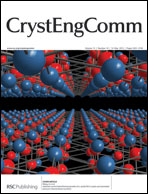BETS3[Cu2(C2O4)3](CH3OH)2: an organic–inorganic hybrid antiferromagnetic metal (BETS = bisethylene(tetraselenfulvalene))†
Abstract
The organic–inorganic hybrid charge-transfer salt of BETS and a two-dimensional oxalate–metalate: BETS3[Cu2(C2O4)3](CH3OH)2 (1) was obtained by the electrochemical oxidation of neutral BETS in the presence of [(C2H5)3NH]2Cu(C2O4)2 in a C6H5Cl–CH3OH solution. 1 crystallizes in a triclinic crystal system with cell parameters: a = 8.7716(3) Å, b = 16.9903(6) Å, c = 20.5716(7) Å, α = 104.794(2)°, β = 102.209(2)°, γ = 92.243(2)°, V = 2883.1(2) Å3 and P1 in 293 K. Donor layers and Jahn–Teller distorted honeycomb anions stack alternatively along the c axis in 1. The crystal structure of 1 is similar to the reported compound [BEDT–TTF]3[Cu2(C2O4)3](CH3OH)2 (BEDT–TTF = bis(ethylene-dithio)tetrathiafulvalene, ET). Compared with the BEDT–TTF salt, the c axis expands by 2.3% at room temperature, the shorter interaction between the donor molecules increases, the room temperature conductivity increases from 4 S cm−1 to 140 S cm−1 and the antiferromagnetic interaction between the metal atoms with Jahn–Teller distortion through the oxalato-bridge enhances.
2: an organic–inorganic hybrid antiferromagnetic metal (BETS = bisethylene(tetraselenfulvalene))](/en/Image/Get?imageInfo.ImageType=GA&imageInfo.ImageIdentifier.ManuscriptID=C2CE26552D&imageInfo.ImageIdentifier.Year=2013)

 Please wait while we load your content...
Please wait while we load your content...